Vancouver, British Columbia: FIREWEED METALS CORP. (“Fireweed” or the “Company”) (TSXV: FWZ; OTCQB: FWEDF, formerly Fireweed Zinc Ltd.) is pleased to announce the first results of the 2022 drill program at their flagship Macmillan Pass zinc-lead-silver project, located within the prolific Selwyn Basin zinc district of Yukon, Canada (Map 1).
Highlights
- At Boundary West Hole NB22-002 intersected high-grade massive sulphides and veins: 124 m of 12.3% zinc, 1.3% lead, and 45.9 g/t silver including 60 m of 19.0% zinc, 1.6% lead, and 64.7 g/t silver, the best ever intersection recorded anywhere at Macmillan Pass, in terms of grade x thickness.
- Step-out hole NB22-002 successfully extended the Boundary West massive sulphide mineralization, which remains open in multiple directions, including towards where geological vectors suggest a feeder zone may be present in which higher grades and thicknesses may be found.
- Hole NB22-002 also intersected a new zone of massive sulphide and volcanics over 18.5 m grading 6.15% zinc, 0.39% lead, and 14.3 g/t silver that remains open to the south.
CEO Statement
Brandon Macdonald, CEO, stated “The first results from the 2022 program include the best intersection that we have ever had at Boundary Zone, or anywhere on the property including our Tom and Jason deposits. Boundary West seems to get higher grade the more we chase it to depth, and we see great potential for this massive sulphide zone—it is open along strike on both sides, and at depth, including in the direction toward the potential feeder structure. These are exceptional assays to kick off reporting of our 2022 drill results.”.
NB22-002
Diamond drill hole NB22-002 intersected a long interval of high-grade, dense massive sulphide and vein-hosted mineralization from a downhole depth of around 286 m: 124.49 m of 12.31% zinc, 1.31% lead, and 45.9 g/t silver (Tables 1 and 4, Cross Section D-D’). The massive sulphides comprise pyrite and sphalerite with minor galena (Photo 1). This massive sulphide interval contains higher grade sections, for example, 59.96 m of 19.04% zinc including 18.27 m of 28.1% zinc (Tables 1 and 4). An interval of lead-silver rich, very-high grade massive sulphide mineralization grading 25.18% Zn, 9.39% lead, and 166.9 g/t silver over 4.26 m (Photo 2) occurs downhole of the massive sulphides and is tentatively interpreted to be a lateral equivalent of the high-grade lead-silver rich laminated zinc mineralization intercepted in nearby drillholes (e.g. NB21-002; see Fireweed news release dated September 16th 2021 for details).
Table 1: NB22-001 and NB22-002 drilling highlights, Boundary West. MS: Massive Sulphide, Vo: Volcanic, V: Veins, LS: Laminated Sulphide. Intersected widths reported in this table; true widths estimated at 60-80% of intersected widths.
MS: Massive Sulphide, Vo: Volcanic, V: Veins, LS: Laminated Sulphide. Intersected widths reported in this table; true widths estimated at 60-80% of intersected widths.
The increase in zinc, lead and silver grades towards the east and with depth at Boundary West suggests that the feeder structure is located to the east and/or at depth from hole NB22-002, where the massive sulphide zone remains open. The massive sulphide mineralization is also open at depth to the west of hole NB21-002 (Map 2). Laminated barite occurs within the massive sulphide (~366-375 m) and silicified black mudstone occurs around the margins of the zone.
An apparent offset of approximately 40 m to 50 m relative to other intersections of the massive sulphide zone reported from Boundary West to date, coupled with the absence of directly overlying massive sulphide in an adjacent hole (NB22-007, see Cross Section D-D’), lead to the interpretation that the massive sulphides intersected in NB22-002 are separated by a small-scale fault from the rest of the massive sulphides previously drilled at Boundary West. Angles of bedding to core axis within and on either side of the massive sulphides suggest that true thicknesses are likely to be approximately 60% to 80% of intersected thickness. Additional drilling is required to determine any potential extension of the massive sulphide to the east and to more accurately delineate structure and true thicknesses.
An additional intersection of a new zone of dense massive sulphide and volcanic-hosted mineralization only 130 m vertically from surface graded 6.15% zinc, 0.39% lead, and 14.3 g/t silver over 18.52 m including 7.41 m of 10.15% zinc, 0.73% lead, and 24.3 g/t silver (Tables 1 and 4, Cross Section D-D’). This represents a new zone of zinc mineralization that opens up the potential for additional mineralization at Boundary West towards the south.
NB22-001
Diamond drill hole NB22-001 resulted in a successful step-out intersection of the laminated zinc mineralization at Boundary West of 4.87 m grading 6.71% zinc, 1.56% lead, and 40.5 g/t silver (Tables 1 and 4, Cross Section D-D’). NB22-001 also demonstrated continuity of the massive sulphide zone at Boundary West with a separate 38.27 m intersection of dense massive pyrite-sphalerite and minor vein-hosted sphalerite that graded 1.22% zinc, 0.04% lead, and 14.9 g/t silver (Table 4).
Data verification
The diamond drill core logging and sampling program was carried out under a rigorous quality assurance / quality control program using industry best practices. Drill intersections in this release are all HQ3 (split tube) size core (61.1mm / 2.4-inch diameter) with recoveries typically above 85% unless otherwise noted in the table of results. After drilling, core was logged for geology, structure, and geotechnical characteristics, then marked for sampling and photographed on site. The cores for analyses were marked for sampling based on geological intervals with individual samples 1.5 m or less in length. Drill core was cut lengthwise in half with a core saw; half-core was sent for assays reported in this news release, and the other half is stored on site for reference. Bulk density was determined on site for the entire length of each sample assayed by measurement of mass in air and mass in water. Sample duplicate bulk density determinations and in-house bulk density standard determinations were each made at a rate of 5%. Since 2017, four in-house bulk density standards (mineralized drill core from the Tom deposit that span a range of densities) have been used and show an acceptable long-term precision. Certified standard masses are used to calibrate the scale balance used for bulk density determinations.
A total of 5% assay standards or blanks and 5% core duplicates are included in the sample stream as a quality control measure and are reviewed after analyses are received. Standards and blanks in 2022 drill results to date have been approved as acceptable. Duplicate data add to the long-term estimates of precision for assay data on the project and precision for drill results reported is deemed to be within acceptable levels. Samples were sent to the Bureau Veritas preparation laboratory in Whitehorse, Yukon, where the samples were crushed and a 500 g split was sent to the Bureau Veritas laboratory in Vancouver, B.C to be pulverized to 85% passing 200 mesh size pulps. Clean crush material was passed through the crusher and clean silica was pulverized between each sample. The pulps were analyzed by 1:1:1 Aqua Regia digestion followed by Inductively Coupled Plasma Mass Spectrometry (ICP-ES/ICP-MS) multi-element analyses (BV Code AQ270). All samples were also analyzed for multiple elements by lithium borate fusion and X-ray fluorescence analysis (XRF) finish (BV Code LF725). Over-limit Pb (>25.0%) and Zn (>24.0%) were analyzed by lithium borate fusion with XRF finish (BV Code LF726). Silver is reported in this news release by method AQ270, and zinc and lead are reported by LF725 or LF726. Bureau Veritas (Vancouver) is an independent, international ISO/IEC 17025:2005 accredited laboratory.
Results in this news release are length and bulk-density weighted averages as would be used in a Mineral Resource estimate. Readers are cautioned that in Fireweed news releases prior to 2020, only length weighted assay averages were reported which may result in slightly lower (under-reported) average values. Length and bulk-density weighted averages have been reported as these most accurately represent the average metal-content of the intersections.
Qualified Person Statement
Technical information in this news release has been approved by Dr. Jack Milton, P.Geo., Chief Geologist and a ‘Qualified Person’ as defined under Canadian National Instrument 43-101.
About Fireweed Metals Corp. (TSXV: FWZ; OTCQB: FWEDF; FSE:20F): Fireweed Metals is a public mineral exploration company on the leading edge of Critical Minerals project development. The Company has three projects located in northern Canada:
- Macmillan Pass Zinc-Lead-Silver Project: Fireweed owns 100% of the district-scale 940 km2 Macmillan Pass project in Yukon, Canada, which is host to the Tom and Jason zinc-lead-silver deposits with current Mineral Resources and a PEA economic study (see Fireweed news releases dated 10th January 2018, and 23rd May 2018, respectively, and reports filed on sedar.com for details) as well as Boundary Zone (including Boundary Main and Boundary West), Tom North and End Zone which have significant zinc-lead-silver mineralization drilled but not yet classified as mineral resources. The project also includes large blocks of adjacent claims with known showings and significant upside exploration potential. A large, four-rig 2022 drill program is now complete and assays are being reported as they are received and interpreted.
- Mactung Tungsten Project: The Company has a binding Letter of Intent to acquire 100% interest in the 37.6 km2 Mactung Tungsten Project located adjacent to the Macmillan Pass Project. Mactung contains historic resources that make it one of the largest and highest-grade undeveloped tungsten resources in the world. Located in Canada, it is one of the rare large tungsten resources outside of China. Due diligence and validation work on historic data as well as relogging and sampling of historic drill core is underway and will support a new mineral resource estimate.
- Gayna River Zinc-Gallium-Germanium Project: Fireweed has 100% of the 128.75 km2 Gayna River project located 180 kilometres north of the Macmillan Pass project. It is host to extensive critical minerals mineralization including zinc, gallium and germanium as well as lead and silver, outlined by 28,000 metres of historic drilling and significant upside potential. The 2022 field program of airborne LiDAR topographic surveying, and ground gravity geophysics was recently completed, and data is being interpreted toward defining 2023 drill targets.
In Canada, Fireweed (TSXV: FWZ) trades on the TSX Venture Exchange. In the USA, Fireweed (OTCQB: FWEDF) trades on the OTCQB Venture Market for early stage and developing U.S. and international companies and is DTC eligible for enhanced electronic clearing and settlement. The Company is current in its reporting and undergoes an annual verification and management certification process. Investors can find Real-Time quotes and market information for the Company on www.otcmarkets.com. In Europe, Fireweed (FSE: 20F) trades on the Frankfurt Stock Exchange.
Additional information about Fireweed and its projects can be found on the Company’s website at www.FireweedMetals.com and at www.sedar.com .
ON BEHALF OF FIREWEED METALS CORP.
“Brandon Macdonald”
CEO & Director
Contact:
Brandon Macdonald
Phone: (604) 646-8361
Email: info@fireweedmetals.com
Neither the TSX Venture Exchange nor its Regulation Services Provider (as that term is defined in the policies of the TSX Venture Exchange) accepts responsibility for the adequacy or accuracy of this release.
Cautionary Statements
Forward Looking Statements
This news release may contain “forward-looking” statements and information relating to the Company and its projects that are based on the beliefs of Company management, as well as assumptions made by and information currently available to Company management. Such statements reflect the current risks, uncertainties and assumptions related to certain factors including but not limited to, without limitations, exploration and development risks, expenditure and financing requirements, general economic conditions, changes in financial markets, the ability to properly and efficiently staff the Company’s operations, the sufficiency of working capital and funding for continued operations, title matters, First Nations relations, operating hazards, political and economic factors, competitive factors, metal prices, relationships with vendors and strategic partners, governmental regulations and oversight, permitting, seasonality and weather, technological change, industry practices, and one-time events. There is no assurance that technical interpretations and projections described in this news release, including but not limited to how they may relate to a potential high grade feeder structure at the Boundary West Zone, are correct, and accordingly, readers are advised not to place undue reliance on such forward looking statements. Should any one or more risks or uncertainties materialize or change, or should any underlying assumptions prove incorrect, actual results and forward-looking statements may vary materially from those described herein. The Company does not undertake to update forward‐looking statements or forward‐looking information, except as required by law.
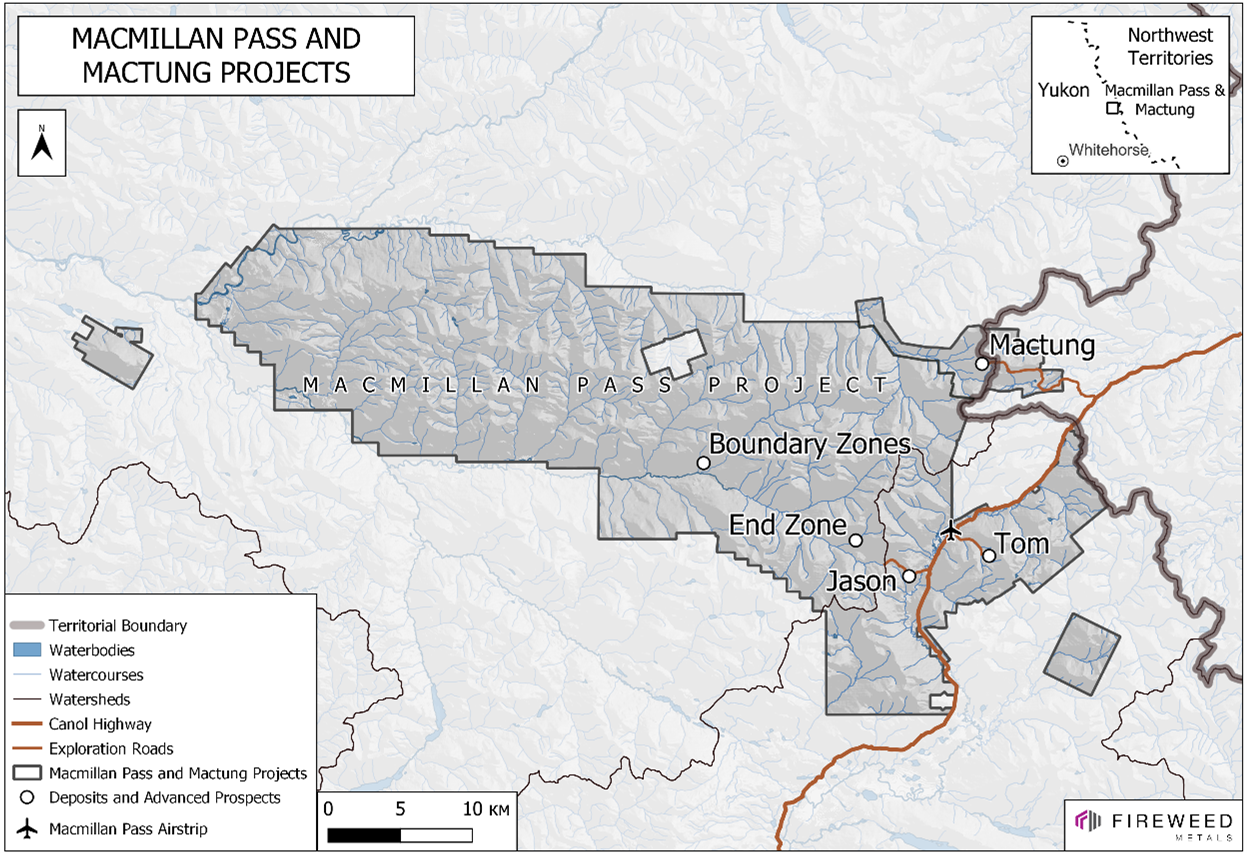
Map 1: Macmillan Pass and Mactung location map.

Map 2: Boundary Zone drilling and location of cross-section D-D’.
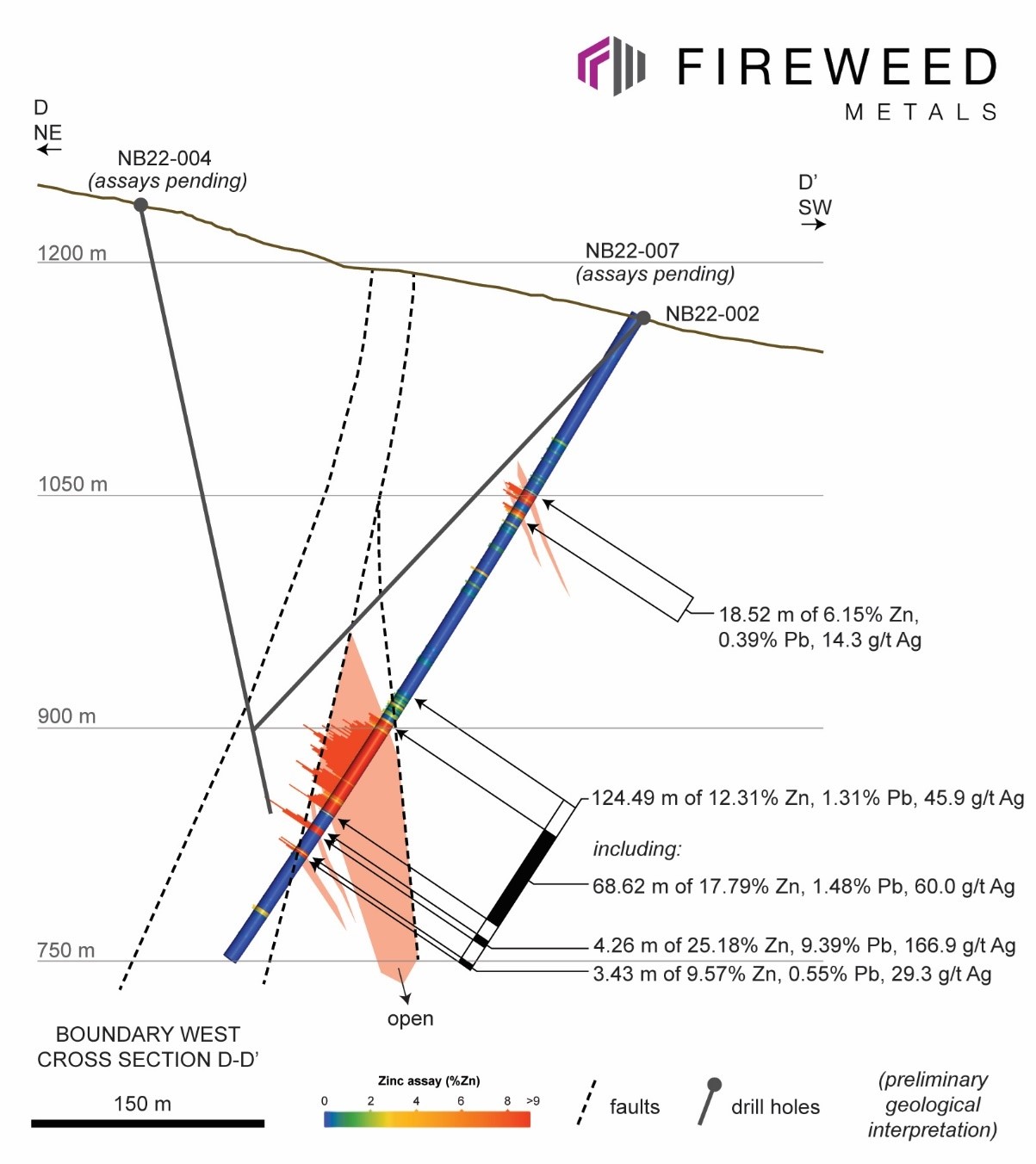
Cross-section D-D’ showing preliminary interpretation of the mineralized zone around NB22-002. Detailed visual mineralization observations have not yet been disclosed for holes NB22-004 and NB22-007 as assays are pending for these two holes.

Photo 1 Scanned images of massive sulphide mineralization core, NB22-002: 337.1-340.2 m. Images are from within a broader interval of 18.27 m of 28.1% Zn, 0.65% Pb, and 68.4 g/t Ag.

Photo 2 Scanned images of massive sulphide core from NB22-002: 388.4 m to 393.6 m visible. Interval 388.98-393.24 m graded 25.18% Zn, 9.39% Pb, 166.9 g/t Ag.
Table 2: Summary of drill results from 2022 program
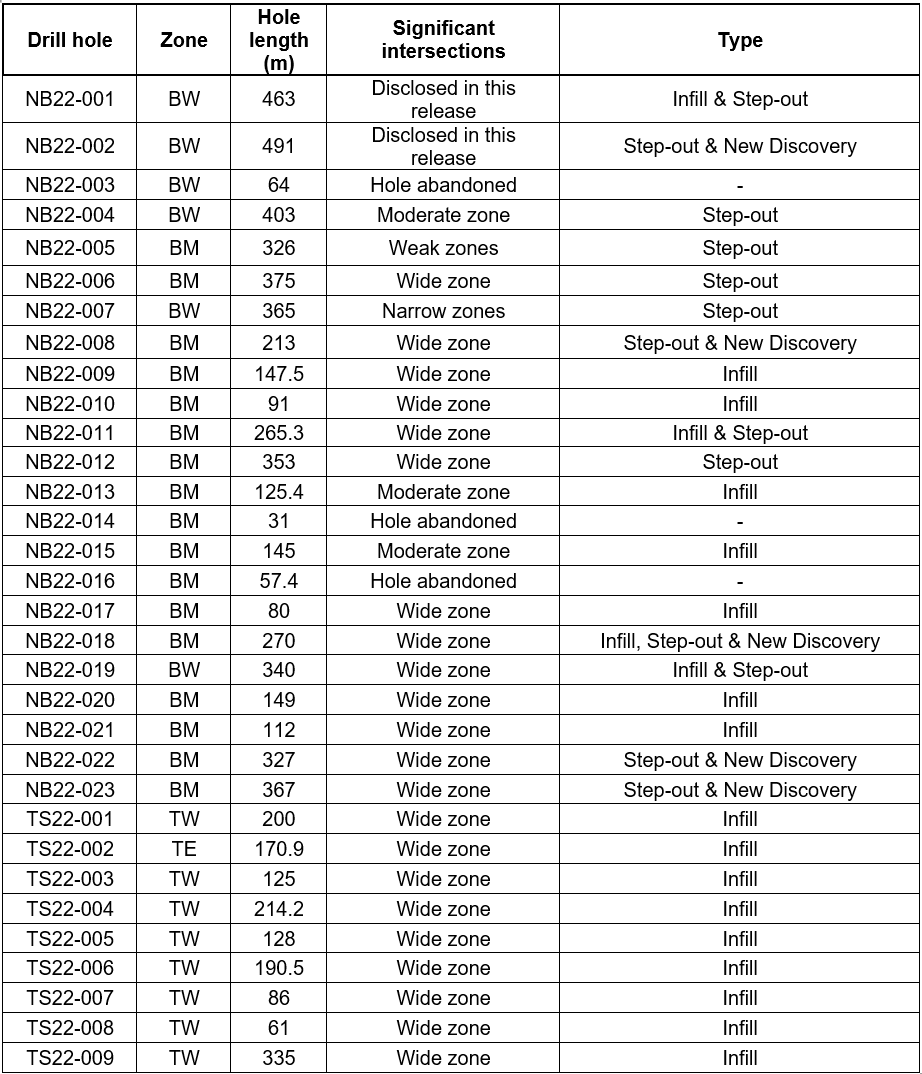
All assays pending unless otherwise indicated. BM: Boundary Main; BW: Boundary West; TW: Tom West; TE: Tom East.
Table 3: 2022 drill collar details
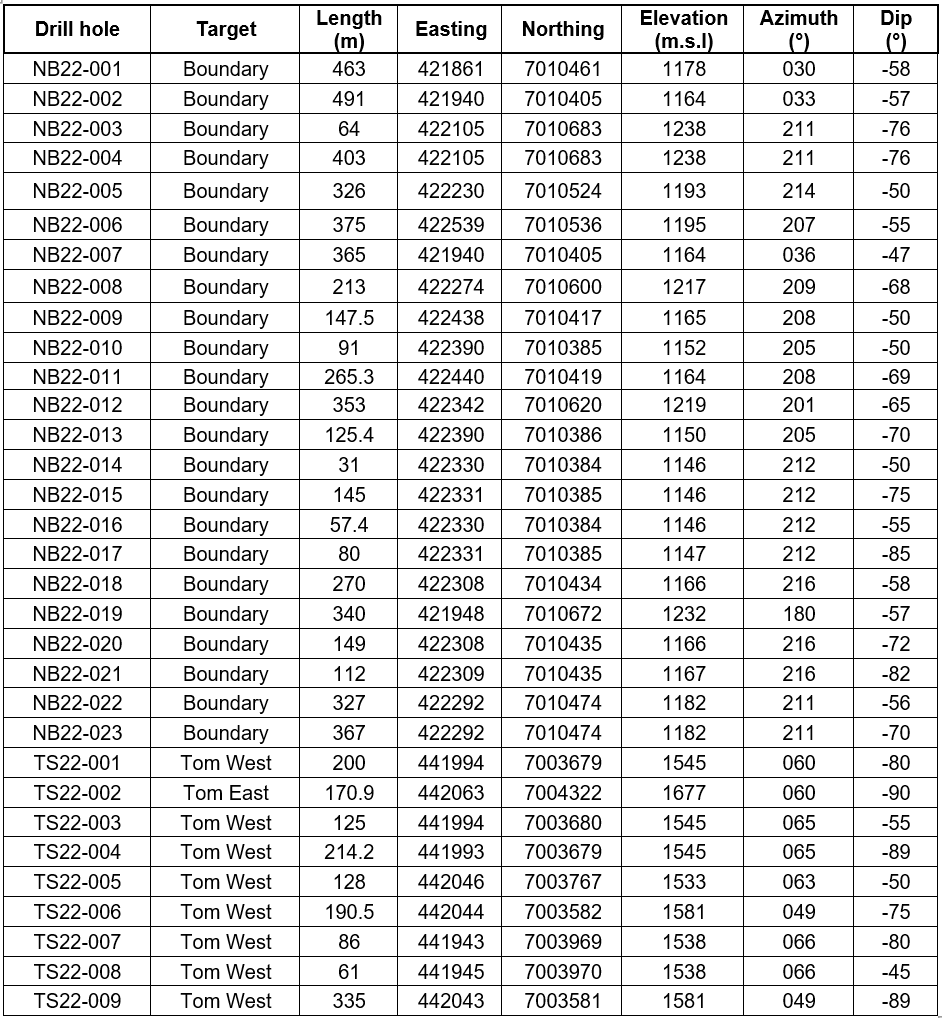
Coordinate reference system: UTM Zone 9 NAD83. North reference: UTM grid north.
Table 4: NB22-001 and NB22-002 full drill results table.
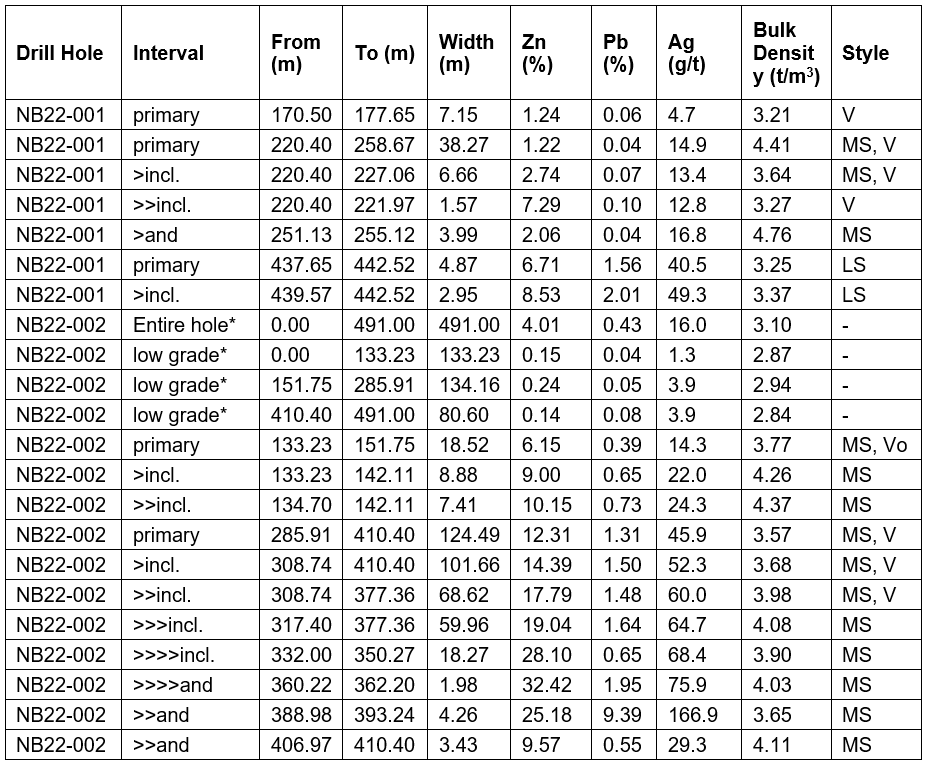
MS: Massive sulphide, Vo: Volcanic, V: Veins, LS: Laminated Sulphide. Intersected widths reported in this table. True widths estimated at 60-80% of intersected widths. *The length and bulk density weighted average grades have been calculated for the entire hole, including three significant intervals of very low average grades.

